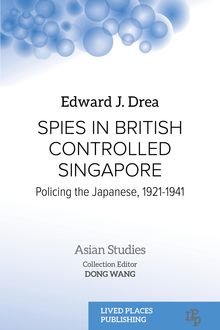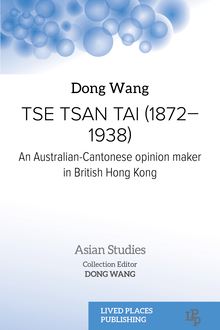-
 Univers
Univers
-
 Ebooks
Ebooks
-
 Livres audio
Livres audio
-
 Presse
Presse
-
 Podcasts
Podcasts
-
 BD
BD
-
 Documents
Documents
-
- Cours
- Révisions
- Ressources pédagogiques
- Sciences de l’éducation
- Manuels scolaires
- Langues
- Travaux de classe
- Annales de BEP
- Etudes supérieures
- Maternelle et primaire
- Fiches de lecture
- Orientation scolaire
- Méthodologie
- Corrigés de devoir
- Annales d’examens et concours
- Annales du bac
- Annales du brevet
- Rapports de stage
La lecture à portée de main
Vous pourrez modifier la taille du texte de cet ouvrage
Découvre YouScribe en t'inscrivant gratuitement
Je m'inscrisDécouvre YouScribe en t'inscrivant gratuitement
Je m'inscrisEn savoir plus
Vous pourrez modifier la taille du texte de cet ouvrage
En savoir plus

Description
Imagine being Japanese, living in Singapore in the nineteen twenties and thirties, suspected by everyone around you of being a spy.
Prior to December 1941, Singapore was the site of a major naval base for the occupying British. As tensions increased between the imperial powers of Japan and Britain, Japanese expatriates living in Singapore became the focus of both governments in the struggle for control and power, resulting in further marginalization, suspicion, and othering from the Singapore authorities.
Based on British police records and Japanese military records of the time, this book explores what it meant to be Japanese in those circumstances, and how people were used – sometimes without their knowledge and consent – as spies and intelligence agents.
Preface
Learning objectives
Introduction
1: The First Spy Scandal
2: Under Suspicion
3: Tokyo Reconsiders a Singapore Strategy
4: Another Singapore Spy Scandal
5: The Imperial Japanese Army Takes Charge
6: The Singapore Consulate and Fifth Columns
7: Final Measures, the Singapore Consulate and the KAME
Aftermath
Suggested Projects and Discussion Topics
Sujets
Asian Studies
Ethnic Studies
Social History
20th Century
Social Science
HISTORY
POLITICAL SCIENCE
EDUCATION
Sociologie, société et politique
Reino Unido
Military history
East Asia
Higher
Level
General officer
Military intelligence
Military
United Kingdom
Southeast Asia
School
Singapore
History of Asia
Japan
Great Britain
General
Malaya
Asia
Social
Migration
Discrimination
Singapour
Royaume-Uni
Europe
Informations
| Publié par | Lived Places Publishing |
| Date de parution | 22 février 2023 |
| Nombre de lectures | 0 |
| EAN13 | 9781915271730 |
| Langue | English |
Informations légales : prix de location à la page 0,1250€. Cette information est donnée uniquement à titre indicatif conformément à la législation en vigueur.
Extrait
SPIES IN BRITISH CONTROLLED SINGAPORE
Dr Edward J. Drea
SPIES IN BRITISH CONTROLLED SINGAPORE
Policing the Japanese, 1921–1941
The Asian Studies Collection
Collection Editor
Dr Dong Wang
For Rika
First published in 2023 by Lived Places Publishing.
All rights reserved. No part of this publication may be reproduced, stored in a retrieval system, or transmitted in any form or by any means, electronic, mechanical, photocopying, recording or otherwise, without prior permission in writing from the publisher.
The authors and editors have made every effort to ensure the accuracy of information contained in this publication, but assume no responsibility for any errors, inaccuracies, inconsistencies and omissions. Likewise, every effort has been made to contact copyright holders. If any copyright material has been reproduced unwittingly and without permission the Publisher will gladly receive information enabling them to rectify any error or omission in subsequent editions.
Copyright © 2023 Lived Places Publishing
British Library Cataloguing in Publication Data
A CIP record for this book is available from the British Library
ISBN: 9781915271723 (pbk)
ISBN: 9781915271747 (ePDF)
ISBN: 9781915271730 (ePUB)
The rights of Edward J. Drea to be identified as the Author of this work have been asserted by him in accordance with the Copyright, Design and Patents Act 1988.
Cover design by Fiachra McCarthy
Book design by Rachel Trolove of Twin Trail Design
Typeset by Newgen Publishing UK
Lived Places Publishing
Long Island
New York 11789
www.livedplacespublishing.com
Abstract
Before December 1941, Singapore was the site of a major naval base for the occupying British. As tensions increased between the imperial powers of Japan and Britain, Japanese expatriates living in Singapore became the focus of both the British and Japanese governments in the struggle for control and power, resulting in further marginalization and suspicion of resident Japanese by the Singapore authorities who othered the communities in which they lived.
Based on British police records and Japanese military records of the time, this book explores how people were used—sometimes without their knowledge and consent—as spies and intelligence agents.
Keywords
Military history; war; espionage; colonialism; empire; migration; expatriate; Malaya; East Asia; Southeast Asia
Contents
Preface viii
Learning objectives
ix Introduction
1 Chapter 1 The first spy scandal
15 Chapter 2 Under suspicion
39 Chapter 3 Tokyo reconsiders a Singapore strategy
55 Chapter 4 Another Singapore spy scandal
71 Chapter 5 The Imperial Japanese Army takes charge
81 Chapter 6 The Singapore consulate and fifth columns
95 Chapter 7 Final measures, the Singapore consulate,
and the KAME
109 Aftermath 123
Suggested projects and discussion topics 132
References 133
Recommended further reading 142
Index 143
Preface
This book originated in my curiosity about the Japanese whom the colonial security police identified as spies. Were the Japanese residents of Singapore enemy agents and, if so, what did they accomplish? From a different perspective, how effective were the colonial police in controlling espionage? Answering these questions meant addressing the combination of interaction between races and cultures in a colonial setting during a period of growing international tensions that influenced Singapore’s domestic policy. British colonial authorities viewed all Japanese with suspicion, but most Japanese residents, while sympathetic to Tokyo, were not involved in espionage or subversion. However, though British concerns may have been exaggerated, Japanese spies did operate within the expatriate community, organized around Singapore’s Japanese consulate that engaged in espionage and subversion. Providing both sides of the story may remove some of the many myths about Singapore’s spies.
My thanks to the following scholars for reading earlier drafts of this manuscript: Raymond Callahan, John Carland, Brian Farrell, Roger Jeans, Gerhard Krebs, and Steve Rabson. I am indebted to Professor Dong Wang for her guidance.
Learning objectives
• Understand the different roles of Japanese civilian residents and Japanese military officers and diplomatic officials in Singapore .
• Understand the relationship between the colonial police in Singapore and the Colonial Office.
• Understand how the Japanese government manipulated Japanese residents of Singapore .
• Be aware of the evolving British attitude toward suspected espionage during the 1920s and 1930s.
Introduction
What role, if any, the Japanese expatriate community played in the collapse of British Malay states has provoked controversy since 1942. Early postwar versions insisted that clandestine Japanese spies posing as businessmen, correspondents, fishermen, photographers, and visitors from Japan were in large measure responsible for Britain ’s disastrous Malayan campaign, which culminated in the loss of Fortress Singapore in early 1942. Later accounts dismissed notions of a treacherous Japan ese fifth column and attributed British defeat to combinations of ineptitude, unpreparedness, and racism. These later accounts were the source of ridicule of British authorities for attributing nefarious aims to the innocuous daily activities of Japanese residents of Malaya in order to conjure up visions of a colony-wide spy ring.
Put differently, British colonial authorities viewed all Japanese nationals with suspicion. The Singapore colonial police and British military representatives repeatedly sought broader powers of arrest and proposed mass internment of Japanese residents of the colony. Just as consistently, London rejected such extreme recommendations, citing precedents of imperial governance rooted in the rule of law. Colonial administrators’ near-obsessive mistrust of the resident Japanese blinded them to the rising nationalism among indigenous Malays, whom many British colonists believed were favorably disposed to their “colonial masters.”
The evidence shows that most Japanese residents, while sympathetic to Tokyo, were not directly involved in espionage or subversion. However, although British concerns were overwrought, Japanese spies did live and work within the expatriate community ; they included respected senior bureaucrats and successful businessmen, rugged fishermen and small shopkeepers, male and female service workers, newspaper reporters, and so forth, and were loosely coordinated by Japan’s Singapore consulate. For their part, Singapore ’s Japanese expatriate s enjoyed Tokyo’s strong support and Japan ’s Foreign Ministry was quick to complain about British treatment of its residents, lodging diplomatic protests or veiled threats of retaliation for perceived injustices. Simultaneously, the Japanese consulate in Singapore was exploiting the Japanese community by using many residents as unwitting or informal accomplices to its ongoing subversion campaign.
Japan ’s Singapore consulate was the hub of Japanese intelligence gathering in Southeast Asia . At first it relied on open-sources—newspapers, official publications and announcements, and firsthand observation—to provide intelligence to Tokyo. During the 1920s, the Japanese consulate worked with its naval attachés to gather mainly open-source intelligence about the emerging Singapore naval base. Such activity was a recognized, and grudgingly accepted, practice of all nations’ diplomatic and consular posts, so long as it did not stray into illegal activity such as espionage or subversion. By the mid-1930s, however, certain Japanese residents of Singapore were actively engaged in clandestine espionage : the illicit acquisition of secret information. The shift caught the British unprepared, and a combination of law (all Singapore residents received equal protections) and London’s own secret services (who determined that the benefits of releasing damning evidence of Japanese espionage operations did not outweigh the risks of compromising their sources) hampered a comprehensive response. These factors also governed British reactions to what might be termed Japan’s espionage surge during 1940 and 1941.
Spy ing, by nature, is secret. Interpretations or opinions about clandestine influences on overall national success or failure are usually conditioned by external factors and extrapolated from results because so few know the hidden inside story. One likely reason the extent of Japanese espionage in Singapore prior to 1942 remains a contented topic is that the British and Japanese got rid of much of their official documentation. With the Japanese at Singapore’s gates in February 1942, British police destroyed most of their own classified files rather than allow them to fall into enemy hands. Similarly, following Japan ’s surrender in the late summer of 1945, rumor spread that the victorious Allies intended to execute any Japanese who had engaged in spy ing or intelligence work, leading Japanese soldiers or petty officials to burn thousands of official military or diplomatic documents to eliminate evidence of incriminating conduct. The historical record on both sides is consequently incomplete and important gaps still remain.
Insofar as is possible, I have relied on contemporary records, both British and Japanese, to offer an accurate, if necessarily incomplete, account of what happened at a specific time and place. Because all the British documents cited are available at The National Archives, Kew repository, I cite these in the narrative in the pattern TNA, file number, digital frame number. Thus, TNA, KV3/426, 9 refers to the ninth digitized frame (not page) of file 426 from The National Archives. As for Japanese language documentation, the Japan Center for Asian Records (JCAR) reference number will guide a reader to the document or the file holding the document. I offer detailed titles of these documents in my “Notes” chapter because t
-
 Univers
Univers
-
 Ebooks
Ebooks
-
 Livres audio
Livres audio
-
 Presse
Presse
-
 Podcasts
Podcasts
-
 BD
BD
-
 Documents
Documents
-
Jeunesse
-
Littérature
-
Ressources professionnelles
-
Santé et bien-être
-
Savoirs
-
Education
-
Loisirs et hobbies
-
Art, musique et cinéma
-
Actualité et débat de société
-
Jeunesse
-
Littérature
-
Ressources professionnelles
-
Santé et bien-être
-
Savoirs
-
Education
-
Loisirs et hobbies
-
Art, musique et cinéma
-
Actualité et débat de société
-
Actualités
-
Lifestyle
-
Presse jeunesse
-
Presse professionnelle
-
Pratique
-
Presse sportive
-
Presse internationale
-
Culture & Médias
-
Action et Aventures
-
Science-fiction et Fantasy
-
Société
-
Jeunesse
-
Littérature
-
Ressources professionnelles
-
Santé et bien-être
-
Savoirs
-
Education
-
Loisirs et hobbies
-
Art, musique et cinéma
-
Actualité et débat de société
- Cours
- Révisions
- Ressources pédagogiques
- Sciences de l’éducation
- Manuels scolaires
- Langues
- Travaux de classe
- Annales de BEP
- Etudes supérieures
- Maternelle et primaire
- Fiches de lecture
- Orientation scolaire
- Méthodologie
- Corrigés de devoir
- Annales d’examens et concours
- Annales du bac
- Annales du brevet
- Rapports de stage








